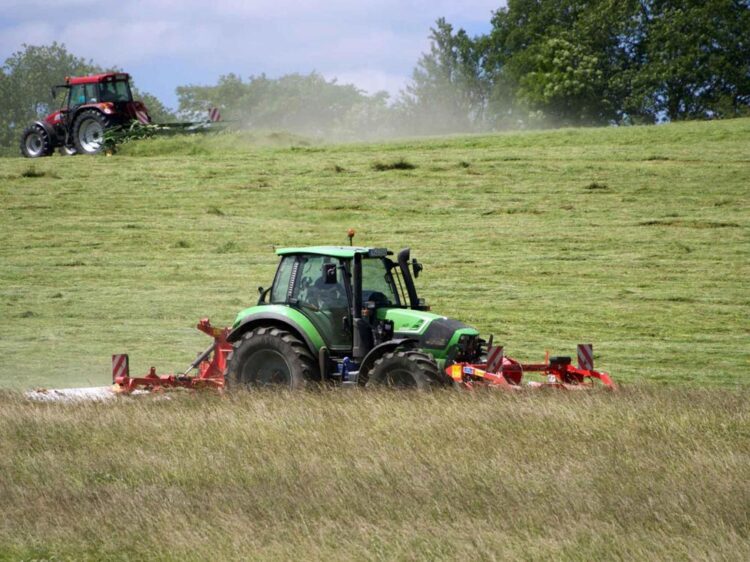Land management in forest and grasslands

In high land-use intensity grasslands, forage quality and biomass are strongly favored, at the expense of other functions and services and multi-trophic diversity.
Credit: Pete Manning
How much can we intensify?
A first assessment of the effects of land management on the links between biodiversity, ecosystem functions and ecosystem services.
Ecosystem services are crucial for human well-being and they depend on a well-functioning ecosystem and complex interactions among many organisms. However, human activities are resulting in biodiversity loss and changes to ecosystems, which threatens the supply of key services. An international team of 32 scientists, from 22 institutions, led by Dr Maria Felipe-Lucia (UFZ, iDiv) and Prof Eric Allan (University of Bern) now present the very first assessment of the simultaneous effects of land-use intensity on biodiversity, ecosystem functions, and services.
A new approach to investigate shifts in the ecosystem
The researchers investigated how these interactions vary with land-use intensity. They analysed data from 300 German grasslands and forests, varying in land-use intensity, and borrowed approaches from network analysis to characterize the overall relationships between biodiversity, ecosystem functions and services.
“We already knew that land use affects biodiversity and ecosystem functioning,” says the lead author of the paper Dr Felipe-Lucia, senior scientist at UFZ and iDiv. “But we knew very little about how land-use intensity simultaneously alters the relationships between diversities, functions and services. By understanding these relationships, we can anticipate how future changes in land use will affect ecosystems and human wellbeing.”
We cannot intensify without limits: varied landscapes are the key
The study demonstrates that low intensity farming and forestry can provide material benefits (fodder, timber), while preserving biodiversity. In contrast, high intensity practices increase material benefits but reduce biodiversity and the benefits people derive from it.
“With increasing land-use intensity we are losing specialized relationships,” Felipe-Lucia concludes. “This is comparable to shopping either in a low-quality mega-store or in a specialized boutique.” Similar to specialized boutiques, where it is necessary to visit many different of them to get the best items, low land-use intensity grasslands and forests are specialized in a particular set of biodiversity, functions and associated services. High land-use intensity landscapes are comparable to mega-stores where all kinds of goods can be found at one place, but of lower quality.
“As in any city, it is ok to have a couple of mega-stores, but we cannot neglect the smaller high-quality boutiques either. In our landscapes, we need to maintain pockets of low land-use intensity to provide these specialized gifts,” explains Allan, senior athour of the paper.
From ecosystem functioning to human-dependent landscapes
In healthy ecosystems, more species usually means higher levels of ecosystem services for people and therefore better human wellbeing. “Intensification tends to homogenize biodiversity-functioning-service relationships and lead to a less integrated system with fewer positive relations between services,” points out Allan. “Diverse low intensity systems can provide different sets of services and a varied landscape could therefore be the key to solve conflicting land uses and provide a wider range of services while preserving biodiversity.”
“We also identified the level of management intensity that disrupts the normal functioning of the landscape, that is, when the ecosystem becomes more dependent on human inputs (such as fertilizer) for its functioning,” says Felipe-Lucia.
The new analyses can help to detect the loss of correlations between biodiversity and ecosystem services, which could be taken as an early warning signal of ecosystem change. “Our approach provides a new and comprehensive view of ecosystem functioning and can identify the key ecosystem attributes to monitor in order to prevent critical shifts in ecosystems,” says Allan. “It can also be applied to analyze the effects of other global changes such as climate change.”
###
The study was conducted in the framework of the Biodiversity Exploratories project, a priority program funded by the Deutsche Forschungsgemeinschaft (DFG).
Media Contact
All latest news from the category: Agricultural and Forestry Science
Newest articles

Scientists transform blood into regenerative materials
… paving the way for personalized, blood-based, 3D-printed implants. Scientists have created a new ‘biocooperative’ material based on blood, which has shown to successfully repair bones, paving the way for…

A new experimental infection model in flies
…offers a fast and cost-effective way to test drugs. Researchers at the Germans Trias i Pujol Research Institute and Hospital have reinforced their leading role in infectious disease research by…

Material developed with novel stretching properties
KIT researchers produce metamaterial with different extension and compression properties than conventional materials. With this material, the working group headed by Professor Martin Wegener at KIT’s Institute of Applied Physics…



